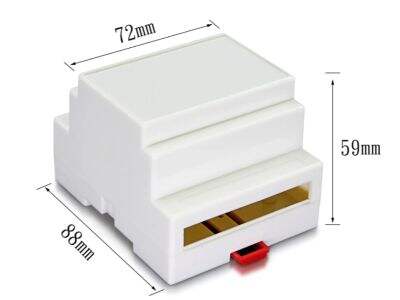Spuitgieten (in principe) is waar vloeibaar plastic in een mal wordt geperst (om vormen te maken). Een mal is een lege ruimte waar het plastic materiaal doorheen kan stromen om zijn vorm te krijgen. Zodra de mal op zijn plaats zit, laat men het gesmolten plastic afkoelen. Plastic wordt hard genoeg om na het afkoelen als een matrijs te worden gevormd. We kunnen eenvoudig plastic speelgoed voor kinderen maken en complexe chirurgische instrumenten voor artsen.
Gebruikte kunststof materialen:
Spuitgietkunststoffen Kunststoffen zijn er in vele vormen, maten, samenstellingen en eigenschappen. Elk type kunststof heeft zijn eigen kenmerken en voordelen. Hier zijn er een paar:
Polyethyleen (PE) is een van de meest gebruikte kunststoffen en wordt gebruikt in een scala aan toepassingen. Je ziet het in plastic zakken en melkkannen. Gevulkaniseerd rubber is vormbaar, ondersteunt gewicht en is ondoordringbaar voor de meeste chemicaliën die andere materialen vernietigen.
Polystyreen (PS): Een lichtgewicht, zeer stijf type plastic. Wordt meestal gebruikt voor verpakkingen zoals dozen of containers en producten voor eenmalig gebruik. Je kunt het in grote breedte vormen en het heeft ook een duidelijke betekenis: je kunt erdoorheen worden waargenomen.
ABS (Acrylonitril-butadieen-styreen): Dit ABS kunststof injectiebehuizing is een taai en sterk plastic dat ook in veel automobieltoepassingen wordt gebruikt, met andere woorden, in een auto. Het is bestand tegen stoten, wat betekent dat het niet zal breken als het een klap krijgt, dus het kan goed tegen hitte. Het heeft ook uitstekende mechanische eigenschappen, waardoor het ideaal en waardevol is in veel toepassingen.
Polypropyleen (PP): Een ander veelzijdig, universeel plastic dat wordt gebruikt in alles van alledaagse artikelen tot medische hulpmiddelen. Licht van gewicht, gemakkelijk te dragen en bestand tegen een groot aantal chemicaliën, wat betekent dat het niet snel beschadigd raakt. Het is ook zeer aanpasbaar aan verschillende vormen.
Hoe selecteert u de juiste kunststof voor spuitgieten?
Bij het kiezen van een spuitgietkunststof moet u op een aantal belangrijke factoren letten:
Het plastic moet sterk zijn. Het moet de taak aankunnen waarvoor het bedoeld is. Bijvoorbeeld, een stuk speelgoed waar kinderen mee spelen moet heel stevig zijn. Het moet bestand zijn tegen ruwe behandeling zonder te barsten.
Chemische bestendigheid: Wanneer een product in contact komt met chemicaliën, zoals bijvoorbeeld schoonmaakmiddelen of verpakkingen voor voedsel, is het van cruciaal belang dat het plastic niet wordt beschadigd of vernietigd door die chemische werking.
Temperatuurbestendigheid: Enkele kunststof buitenbehuizing producten kunnen hoge temperatuuromstandigheden of lage temperatuurgebieden gebruiken. Dus het plastic zal die temperaturen moeten weerstaan zonder schade of vervorming.
Kijk: Het plastic moet niet alleen functioneel zijn, maar het moet er misschien ook op een bepaalde manier uitzien, afhankelijk van de gm. Misschien moet het product doorschijnend zijn, zodat je kunt zien wat erin zit, terwijl andere componenten gekleurd moeten zijn voor een bepaald design.
Andere factoren om over na te denken
Bij het selecteren van een kunststof moeten we ook rekening houden met:
Kosten: De kosten van geld voor sommige soorten plastic verschillen. Een paar zijn glad, terwijl veel erg duur kunnen zijn. Terwijl u met plastic werkt en beslist, moet u in gedachten houden hoeveel het plastic zal kosten.
Productievereisten: Sommige kunststoffen vereisen speciale soorten machines of methoden om ze op de juiste manier te vormen. Dit kan het hele proces ingewikkeld en duur maken.
Milieu-impact: ook hoe dat kunststof injectiebehuizing impact op het milieu moet in acht worden genomen. Niet alle kunststoffen zijn gelijk. Hoewel sommige kunststoffen het slechter doen in de natuur dan andere.
Voor- en nadelen van verschillende soorten kunststoffen
Er zijn verschillende soorten plastics voor spuitgieten met unieke voordelen en beperkingen. Onthoud deze belangrijke punten꞉
Polyethyleen (PE)꞉ PE is goedkoop, gemakkelijk te vormen en goed bestand tegen chemicaliën.
CEC-M4 (een ander type)꞉ Het heeft een hoge diëlektrische sterkte, maar kan slecht tegen hoge temperaturen en heeft een lagere sterkte dan andere kunststoffen.
Polystyreen (PS)꞉ Dit plastic is helder en betaalbaar. Het kan redelijk goed tegen stoten. Maar het is niet goed bestand tegen vocht en heeft moeite met zeer koud weer. Deze beperkingen beperken het gebruik ervan.
Acrylonitril-butadieen-styreen (ABS)꞉ ABS heeft veel voordelen, zoals hoge sterkte en goede hittebestendigheid. Het is ook mooi afgewerkt. De kosten kunnen hoger zijn dan bij andere opties en het vervaagt onder UV-stralen.
Polypropyleen (PP)꞉ PP is goedkoop en is goed bestand tegen chemicaliën. Het is ook bestand tegen vermoeidheid.


